Few things beat the crackle of a fresh, golden baguette cooling on your countertop. But not all homemade baguettes are created equal—some are dense, dry, or lacking the depth of flavor that makes a true French-style loaf memorable. This artisan sourdough baguette recipe uses both a poolish pre-ferment and a natural sourdough starter, creating a crusty, airy interior with just the right amount of chew and complexity.
The process requires a bit of planning and patience, but the reward is undeniable: beautifully blistered baguettes with deep flavor and a satisfying snap. Whether you’re an experienced baker or just venturing into the world of long-fermentation breads, this method strikes a perfect balance of technique and accessibility.
Let’s break it down, from fermentation science to shaping tips, so you can turn out baguettes that might make a Parisian do a double take.
What Sets These Baguettes Apart?
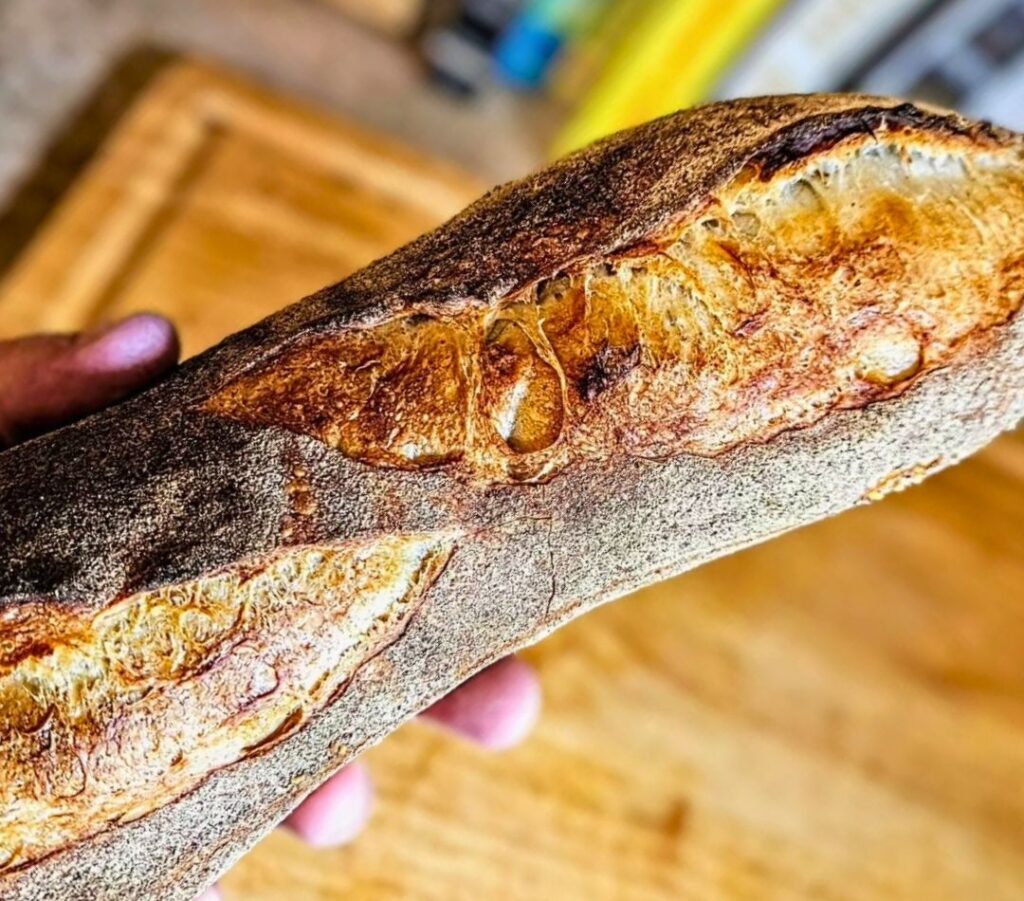
Unlike quick-rise baguettes made with commercial yeast alone, this recipe leans on the power of both poolish and sourdough fermentation. The result? A flavor-rich dough with better structure, aroma, and digestibility.
- Poolish contributes nutty, creamy notes and a lighter crumb texture.
- Sourdough starter adds complex, tangy flavor and extends shelf life naturally.
- Minimal commercial yeast (optional) ensures reliable rise without compromising the artisan character.
This is a slow bread that rewards you with depth and character—not a quick loaf, but a worthwhile one.
Key Ingredients and Their Roles
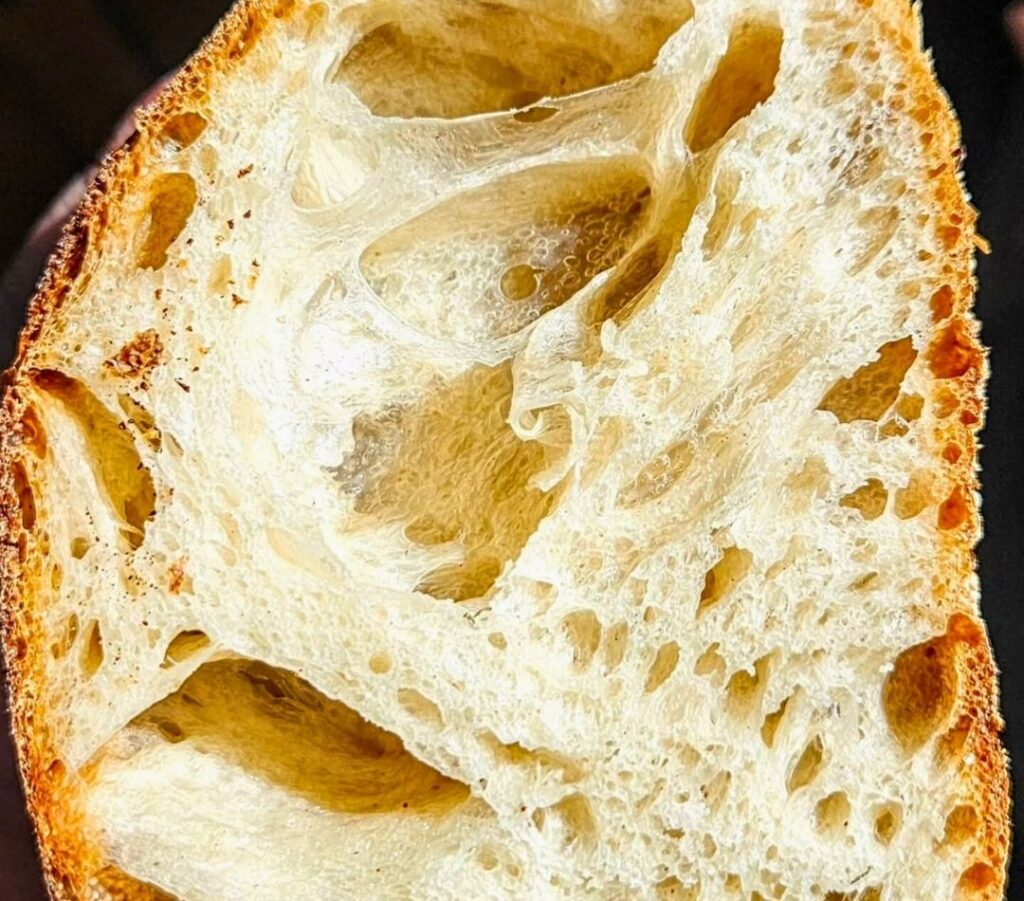
Understanding what goes into your baguette is just as important as how you bake it.
Bread Flour (High Protein): The strong gluten structure of bread flour is essential for that signature baguette chew and open crumb.
Water: Hydration levels matter—aiming for around 70–75% hydration allows for a light, airy interior.
Sourdough Starter: Active and mature, your starter gives the dough acidity, leavening power, and a subtle tang.
Poolish (Flour + Water + Tiny Yeast): Pre-fermenting a portion of flour with yeast boosts aroma, gluten development, and flavor.
Salt: More than a flavor enhancer—salt strengthens gluten and regulates fermentation.
Optional Yeast Boost: A small amount of commercial yeast is added at the final mix to ensure a consistent rise, especially helpful in home kitchens.
Step-by-Step: From Pre-Ferments to Baked Baguettes
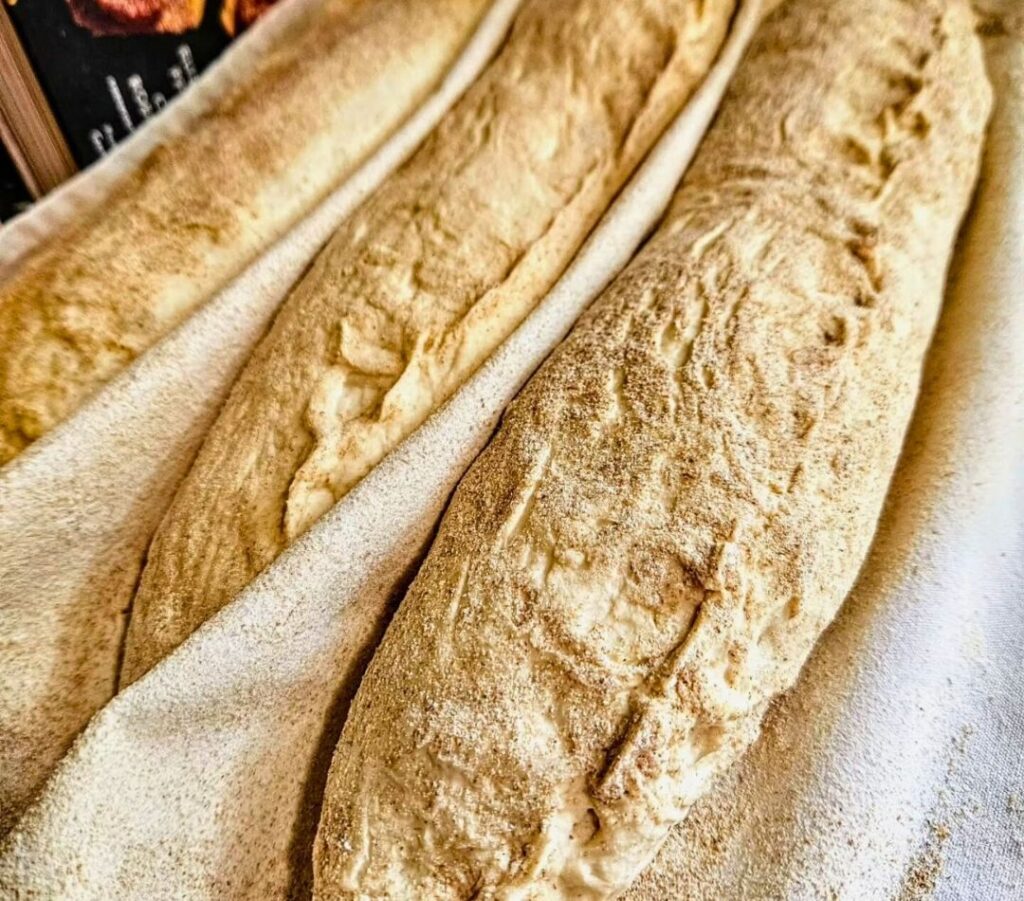
Let’s walk through the timeline and technique, starting a day ahead.
1. Make the Poolish (12 Hours Before)
In a small bowl, combine:
- 125g bread flour
- 125ml water
- A pinch of dry yeast (no more than 1/16 tsp)
Stir until combined. Cover loosely and leave at room temperature for about 12 hours, or until bubbly and doubled in volume.
2. Prepare the Sourdough Starter Mix (4 Hours Before)
In another container, mix:
- 125g bread flour
- 125ml water
- 125g active sourdough starter
Let this sit at room temperature for 4 hours until it becomes aerated and slightly domed.
3. Final Dough Mixing
In a large mixing bowl, combine the poolish, sourdough starter mix, and:
- 250g bread flour
- 175ml water
- 5g active dry yeast (optional, for stability)
Mix by hand or with a dough hook until a shaggy dough forms. Once the flour is fully hydrated and incorporated, allow a 20-minute rest (autolyse).
4. Salt and Final Kneading
Add:
- 10g fine sea salt
Knead for 10–15 minutes until the dough is smooth, elastic, and slightly tacky. If kneading by hand, use the slap-and-fold technique to build strength.
Bulk Fermentation and Folding
Transfer the dough to a lightly oiled bowl. Cover and ferment for 1.5 to 2 hours at room temperature, folding every 30 minutes.
Each fold helps strengthen the dough and develop structure—gently stretch one side of the dough up and fold it over, rotating the bowl as you go.
After the final fold, let the dough rest undisturbed for 30–45 minutes.
Shaping the Baguettes
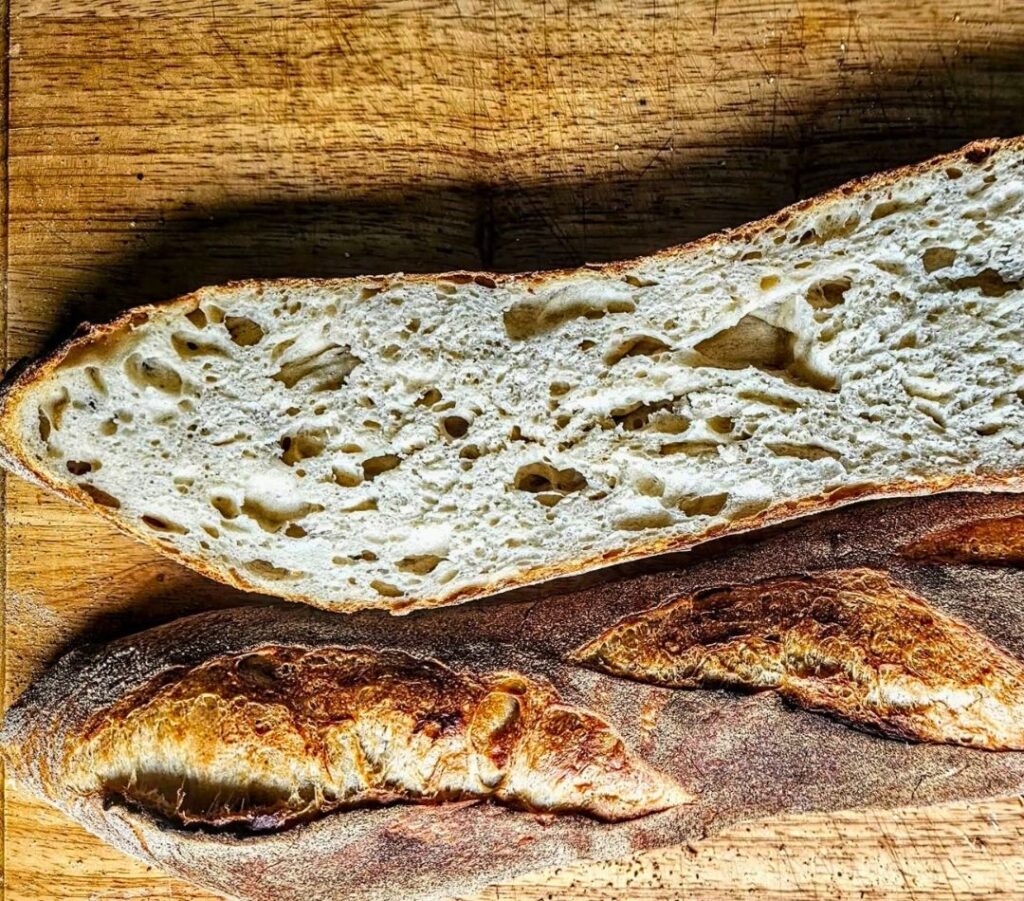
Divide the dough into three equal pieces. Lightly shape into logs, cover, and let rest for 15 minutes.
Then shape each log into a classic baguette:
- Flatten gently into a rectangle.
- Fold the top third down, press to seal.
- Fold the bottom third up and seal again.
- Roll gently from the center outward until the baguette reaches desired length (about 12–14 inches).
Place each shaped baguette onto a floured couche or parchment-lined tray, seam-side down.
Final Proof
Cover loosely with a floured cloth and let rise at room temperature for 1 to 1.5 hours, or until puffy but still slightly springy to the touch.
Avoid over-proofing—baguettes should hold their shape and spring up in the oven.
Scoring and Baking
Preheat your oven to 450°F (230°C) with a baking stone or steel inside and a tray on the bottom for steam.
Just before baking, use a lame or sharp razor to score each baguette with 3 to 5 diagonal slashes.
Steam helps crust development: Add boiling water to the lower tray when placing the baguettes in the oven. Bake for 20–25 minutes until deep golden brown.
For extra crisp crust, let the oven vent (crack the door slightly) during the final 5 minutes.
Cooling and Storing
Let the baguettes cool on a wire rack for at least 30 minutes before slicing. This resting period sets the crumb and enhances flavor.
For storage:
- Keep at room temperature in a paper bag for 1–2 days.
- Re-crisp in a 350°F oven for 5–10 minutes.
- Freeze once cooled for longer storage; reheat directly from frozen.
Tips for Success
- Use a kitchen scale for accurate measurements—especially important for hydration-sensitive doughs.
- Watch the dough, not the clock—fermentation times vary by temperature and starter strength.
- Hydrate properly—if the dough feels too dry during mixing, add water 1 tablespoon at a time.
- For extra blistering, refrigerate the shaped baguettes for 8–12 hours before baking (cold proofing).
- Practice your shaping—technique improves crumb structure and oven spring over time.
Why Use Both Poolish and Sourdough?
Combining a yeasted poolish with sourdough achieves the best of both worlds:
- Better fermentation control
- More nuanced flavor
- Reliable rise and open crumb
- Superior crust development
This hybrid method is especially helpful for home bakers looking for artisan-quality results without managing a full levain schedule.
Final Thoughts
Making baguettes at home can seem daunting, but this method simplifies the process while delivering exceptional results. The combination of sourdough and poolish introduces a depth of flavor and aroma that you simply can’t buy off the shelf.
Whether you serve these with a simple smear of butter or use them for a cheese board centerpiece, these naturally fermented baguettes elevate the everyday into something special.
Let them cool, tear one open, and enjoy the satisfying crackle of a crust done right.
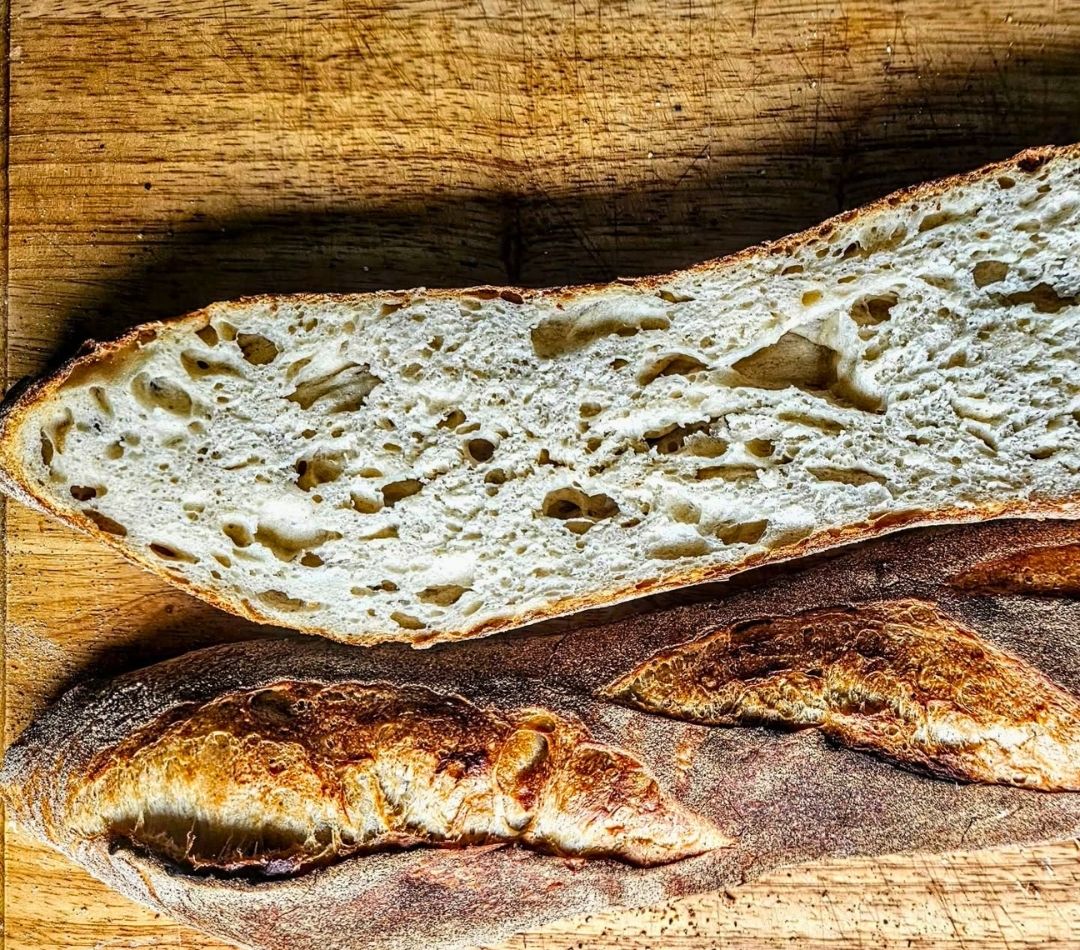
Rustic Sourdough Baguettes with Poolish and Natural Starter
Ingredients
Method
- Mix 125g bread flour and 125ml water with a pinch of active dry yeast to make the poolish. Cover loosely and let it ferment at room temperature for about 12 hours, until bubbly and doubled in size.
- In a separate container, combine 125g bread flour, 125ml water, and 125g active sourdough starter. Let this mixture ferment at room temperature for approximately 4 hours until aerated and slightly domed.
- In a large bowl, combine the prepared poolish, sourdough starter mix, 250g bread flour, 175ml water, and 5g active dry yeast (optional). Mix until a rough dough forms. Allow it to rest (autolyse) for 20 minutes.
- Add 10g fine sea salt to the dough and knead for 10 to 15 minutes until the dough is smooth, elastic, and slightly tacky.
- Place the dough in a lightly oiled bowl, cover, and ferment at room temperature for 1.5 to 2 hours. Perform gentle folds every 30 minutes to develop gluten strength.
- Divide the dough into three equal portions. Shape each into a rough log and rest for 15 minutes.
- Shape each rested portion into a classic baguette by folding and rolling until about 12–14 inches long.
- Place shaped baguettes seam-side down on a floured couche or parchment-lined tray.
- Cover the shaped baguettes loosely with a floured cloth and proof at room temperature for 1 to 1.5 hours until puffed but still slightly springy to the touch.
- Preheat the oven to 450°F (230°C) with a baking stone or steel inside and a tray for steam at the bottom.
- Score the baguettes with 3 to 5 diagonal slashes using a sharp blade or lame.
- Place the baguettes in the oven and add boiling water to the bottom tray to create steam. Bake for 20 to 25 minutes until golden brown and crusty.
- Optionally, crack the oven door open slightly in the last 5 minutes to enhance crust crispness.
- Allow the baked baguettes to cool on a wire rack for at least 30 minutes before slicing to let the crumb set and flavors develop.
Notes
- Use a kitchen scale for precise measurements, especially for hydration.
- Fermentation times may vary depending on room temperature and starter activity; watch the dough rather than the clock.
- If the dough feels dry during mixing, add water gradually, one tablespoon at a time.
- For an extra blistered crust, refrigerate shaped baguettes overnight before baking.
- Store baked baguettes in a paper bag at room temperature up to two days or freeze after cooling for longer storage.




Leave a Reply